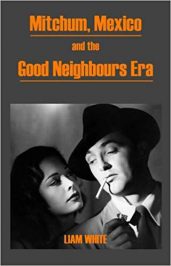Luckily, there is a great number of famous noir films, and many good actors that left their mark on the whole genre. Nevertheless, author White approaches those films mainly as plain detective movies and drama, very much the way they were labeled when they came out. In his opinion there are certain features that can be found in almost all noirs, but then the movies sometimes also carry individual messages.
 As is the case with a string of Robert Mitchum films, an actor who became a familiar face in many noir movies. He starred in His Kind of Woman, Angel Face, Out of the Past, The Big Steal, Second Chance, and Where Danger Lives. All of these are film noir masterpieces.
As is the case with a string of Robert Mitchum films, an actor who became a familiar face in many noir movies. He starred in His Kind of Woman, Angel Face, Out of the Past, The Big Steal, Second Chance, and Where Danger Lives. All of these are film noir masterpieces.
Mitchum received massive attention in the press, not only on behalf of his acting, but also for being a notorious drinker, for communicating an openly leftist worldview and for doing time for possession of marihuana.
Often referred to as the real “King of Cool,” his success finally set in when he starred in a number of movies that all either ended in Mexico or had the country portrayed as a „good neighbor,“ as was the purpose of President Roosevelt’s policy since the early 1930s. Basically the “Good Neighbor Policy” meant mutual cooperation and respect between the US and the nations of Latin America, particularly Mexico.
But why the location and why at his time in history? According to White, from the mid-forties until the mid 1950s, Hollywood suddenly presented an overwhelmingly positive impression about Mexico to American audiences. And there was financial and technical aid coming straight from California (the state actually once being part of Mexican territory not too long ago) to support the Mexican film industry. This deserves mentioning, since in earlier years almost any Mexican character in American movies was either stereotypically uncivilized, criminal, ill-tempered, unshaven, lusting for sex and spoke terrible English with a heavy accent.
All of this financial and political effort was the result of the Office for Coordination of Inter-American Affairs, run by Nelson A. Rockefeller and set up by Roosevelt. The office should promote American policies in Latin America, keeping in mind future possible military actions against the Axis during WWII. Finally, a new production code was designed, that would show the people and culture of Mexico in a very positive light and show the many similarities between the two nations.
The biggest player in the Latin American film industry so far was Argentina, that since the 1930s nourished suspicious collaborations with Nazi Germany, the US decided to build their own political bulwark with the promotion of Mexico’s film industry. Another reason, of course were the plans of the film industry to sell American movies to Mexico since the European market was unavailable during the war.
By 1946 the majority of all Spanish speaking movies was made in this country, that developed an individual style and unique cinematographic ideas; top directors desired to develop cinematic art that stylistically would be close to the renowned Mexican muralism. And some names of the Mexican film industry became world famous, as did actress and former Hollywood star Dolores del Río, director Emilio Fernández and cinematographer Gabriel Figueroa.
After a short blooming from 1943 to 1960, Mexican film’s Golden Age, however, faltered. Until then, Mexico and Latin American citizens were portrayed in a number of positive ways: as country of hard-working men, artists, a place for savoir-vivre, philosophy, dance and music.
White’s analysis of Robert Mitchum’s films staged in Mexico comes to several conclusions in his in-depth analysis of those noir masterpieces. Some conclusions having to do with the actor’s fading success due to bad scripts and character roles that did not allow for his charisma to lift off.
Furthermore, the weakening interest the US had in Latin America due to new challenges like the Marshall Plan and the Cold War, as well as the changing climate in Mexican film industry drew less people in films with such a theme and location. By the late 1950s, Hollywood had almost returned completely to the stereotypical image of Mexico and its citizens just south of the border.
Anyway, this is a very special title with a very particular topic that may not appeal to every film noir buff, but nevertheless a great book for fans of iconic Robert Mitchum.
Review by Dr. A. Ebert © 2016
Liam White. Mitchum, Mexico and the Good Neighbours Era. Chaplin Books, 2014, 223 p.
